Unlock the Thrill: Discover the Secret to Choosing the Perfect Motor for Your Ultimate Electric Skateboard!
The world of electric skateboarding has surged in popularity over the past few years, transforming how enthusiasts commute and enjoy their rides. With the thrill of gliding effortlessly over asphalt, electric skateboards offer a unique blend of convenience and adventure. However, the magic of an electric skateboard lies significantly in its motor. Choosing the right motor is crucial for ensuring optimal performance, speed, and overall enjoyment. In this article, we will dive deep into the various aspects of electric skateboard motors, including types, key specifications, factors to consider, and where to find the best options. Whether you’re customizing your own board or looking to purchase a complete motor skateboard, understanding these elements will help you make an informed decision that enhances your riding experience.

Understanding Electric Skateboard Motors
Electric skateboard motors are the heart of the board, providing the propulsion needed to cruise smoothly and swiftly. At their core, these motors convert electrical energy into mechanical energy, allowing you to glide effortlessly. There are primarily two types of motors used in electric skateboards: hub motors and belt-driven motors. Hub motors are integrated into the wheels, providing a sleek design and reduced maintenance. They offer efficient power delivery and a quieter ride. However, they may not provide as much torque as their belt-driven counterparts. On the other hand, belt-driven motors consist of a motor mounted on the board, connected to the wheels via a belt. This setup allows for higher torque and better acceleration, making them ideal for steep hills and rough terrains. Each motor type has its advantages and disadvantages, so understanding their mechanics is essential for selecting the right one for your needs.
Key Factors to Consider When Choosing a Motor
When selecting a motor for your electric skateboard, several key factors play a crucial role in determining the performance and overall riding experience. First and foremost is power, typically measured in watts. Higher wattage generally translates to better acceleration and speed. Torque is another vital factor, as it dictates how quickly your skateboard can reach its top speed, especially on inclines. Additionally, consider the top speed of the motor—usually measured in kilometers per hour (KPH) or miles per hour (MPH)—to ensure it meets your riding expectations. Efficiency is equally important; a more efficient motor will conserve battery life, allowing for longer rides between charges. Balancing these factors according to your riding style and environment will enhance your experience and ensure you enjoy every ride.
Motor Specifications and Compatibility
Understanding motor specifications is essential for selecting the right motor for your skateboard setup. Key specifications include voltage, wattage, and revolutions per minute (RPM). Voltage affects the speed and power of your motor; higher voltage motors can deliver faster speeds but require matching battery systems. Wattage indicates the motor's power output, while RPM measures how many times the motor's shaft completes a full rotation in a minute—higher RPM means faster speeds. Moreover, ensuring compatibility with your existing skateboard setup is crucial. This includes checking the mounting hardware, battery voltage requirements, and the overall design of your skateboard to avoid any compatibility issues that could hinder performance.
Where to Buy and What to Look For
Finding a reputable source for purchasing electric skateboard motors can be daunting, especially with the plethora of options available online and in physical stores. Start by looking at specialty skate shops and trusted online marketplaces that focus on electric skateboarding. When selecting a seller, check for reviews and ratings from previous customers to gauge their reliability and the quality of their products. Look for warranties or guarantees that indicate the seller stands behind their products. Additionally, be cautious of prices that seem too low, as they may indicate lower-quality components. Taking the time to research and find a trustworthy source will pay off in the long run, ensuring you receive a motor that meets your expectations.
Installation and Maintenance Tips
Installing your new motor can be a rewarding part of the electric skateboard experience. Start by ensuring you have the right tools, including screwdrivers and wrenches. Follow the manufacturer’s installation guide closely to avoid damaging components. After installation, regular maintenance is essential for longevity and optimal performance. Keep the motor clean and free of debris, check the connections for wear, and ensure the belts (if applicable) are tensioned correctly. Regularly inspect the motor for any signs of wear or damage, and address any issues promptly to prolong the life of your skateboard.
Final Thoughts on Choosing the Right Motor
Choosing the right motor for your electric skateboard is a critical decision that influences your overall riding experience. By understanding the different types of motors, their specifications, and key factors to consider, you can make an informed choice that enhances your adventures on wheels. Whether you’re customizing a skateboard or looking to purchase a complete setup, taking the time to research and select the best motor will undeniably elevate your electric skateboarding experience. Embrace the thrill of the ride, and enjoy the freedom that comes with mastering your electric skateboard!






تعليقات